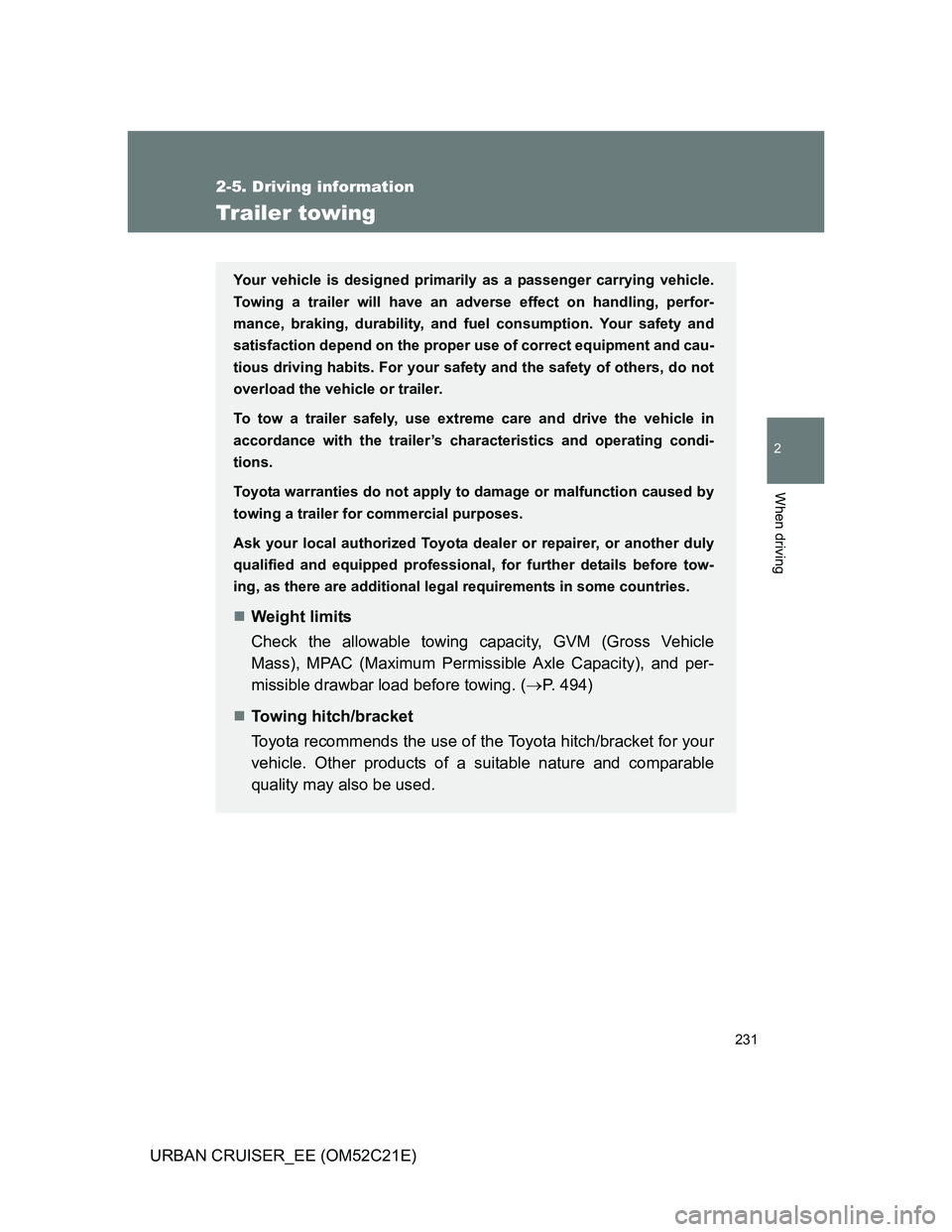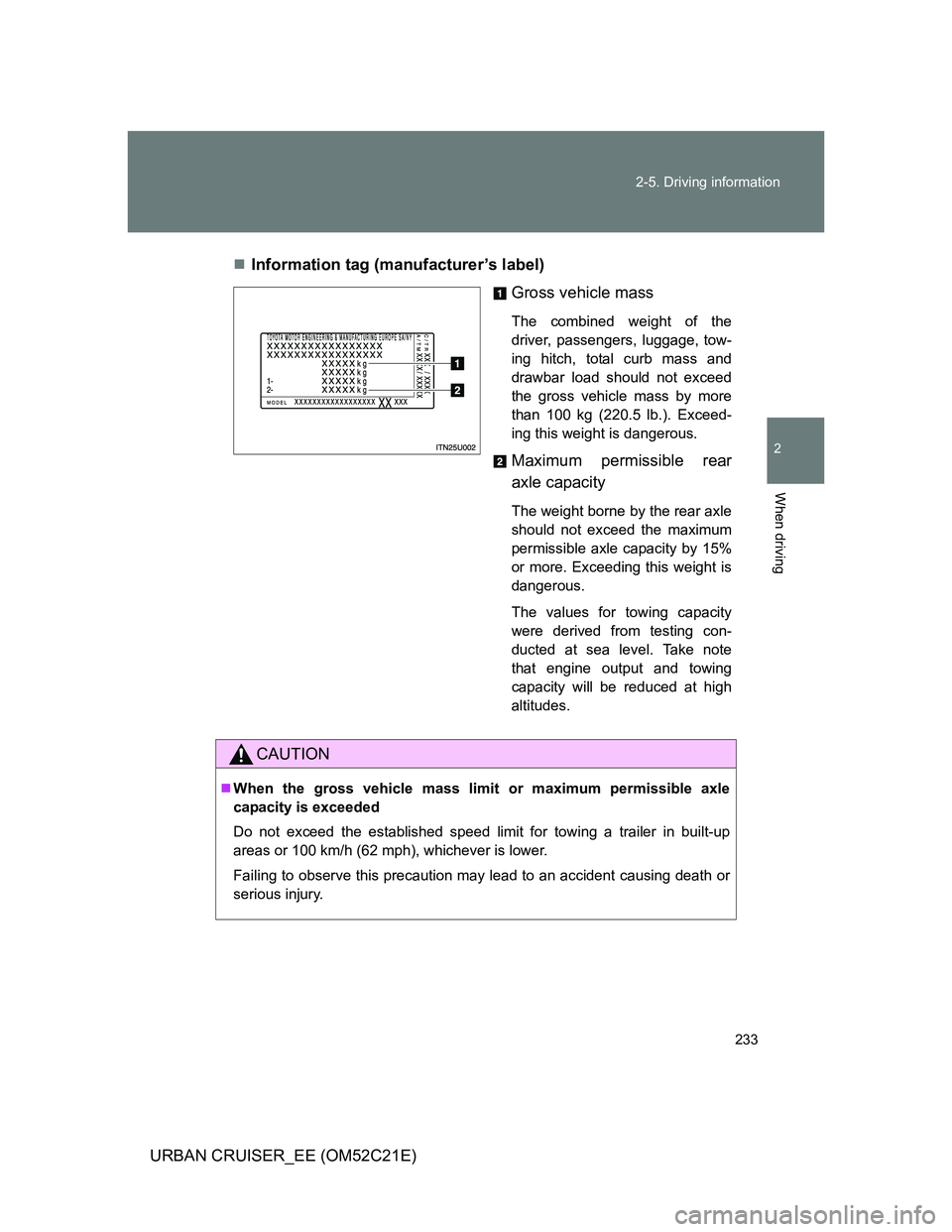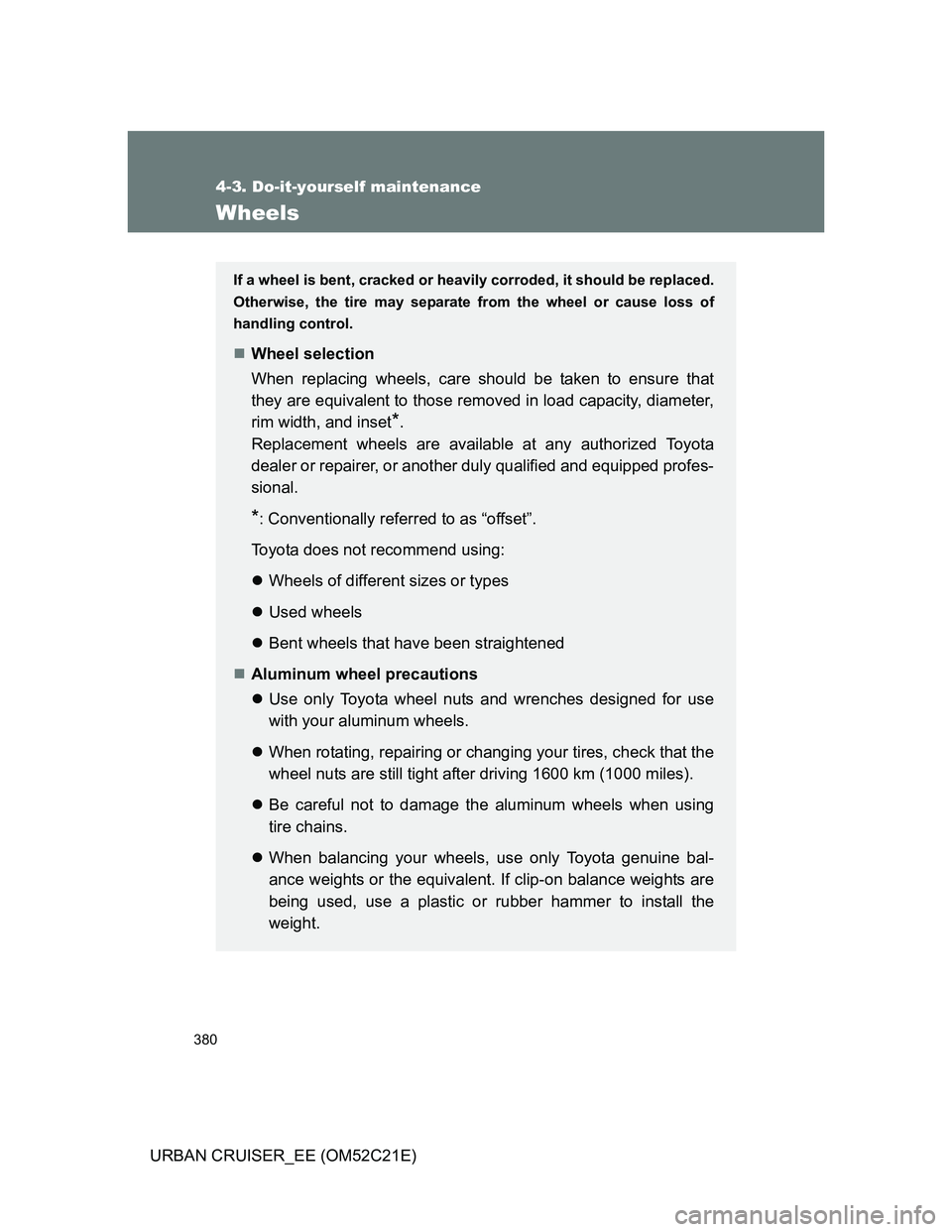Page 222 of 532
222 2-4. Using other driving systems
URBAN CRUISER_EE (OM52C21E)
CAUTION
Replacing tires
Make sure that all tires are of the same size, brand, tread pattern and total
load capacity. In addition, make sure that the tires are inflated to the appro-
priate tire pressure level.
The ABS and VSC systems will not function correctly if different tires are fit-
ted on the vehicle.
Contact any authorized Toyota dealer or repairer, or another duly qualified
and equipped professional for further information when replacing tires or
wheels.
Handling of tires and suspension
Using tires with any kind of problem or modifying the suspension will affect
the driving assist systems, and may cause the system to malfunction.
Page 224 of 532
224
URBAN CRUISER_EE (OM52C21E)
2-5. Driving information
Cargo and luggage
CAUTION
Things that must not be carried in the luggage compartment
The following things may cause a fire if loaded in the luggage compartment:
Receptacles containing gasoline
Aerosol cans
Take notice of the following information about storage precautions,
cargo capacity and load.
Stow cargo and luggage in the luggage compartment whenever
possible.
Be sure all items are secured in place.
To maintain vehicle balance while driving, position luggage
evenly within the luggage compartment.
For better fuel economy, do not carry unnecessary weight.
Page 231 of 532

231
2-5. Driving information
2
When driving
URBAN CRUISER_EE (OM52C21E)
Trailer towing
Your vehicle is designed primarily as a passenger carrying vehicle.
Towing a trailer will have an adverse effect on handling, perfor-
mance, braking, durability, and fuel consumption. Your safety and
satisfaction depend on the proper use of correct equipment and cau-
tious driving habits. For your safety and the safety of others, do not
overload the vehicle or trailer.
To tow a trailer safely, use extreme care and drive the vehicle in
accordance with the trailer’s characteristics and operating condi-
tions.
Toyota warranties do not apply to damage or malfunction caused by
towing a trailer for commercial purposes.
Ask your local authorized Toyota dealer or repairer, or another duly
qualified and equipped professional, for further details before tow-
ing, as there are additional legal requirements in some countries.
Weight limits
Check the allowable towing capacity, GVM (Gross Vehicle
Mass), MPAC (Maximum Permissible Axle Capacity), and per-
missible drawbar load before towing. (P. 494)
Towing hitch/bracket
Toyota recommends the use of the Toyota hitch/bracket for your
vehicle. Other products of a suitable nature and comparable
quality may also be used.
Page 232 of 532
232 2-5. Driving information
URBAN CRUISER_EE (OM52C21E)
Important points regarding trailer loads
Total trailer weight and permissible drawbar load
Total trailer weight
Weight of the trailer itself plus the
trailer load should be within the
maximum towing capacity.
Exceeding this weight is danger-
ous.
(P. 494)
When towing a trailer, use a fric-
tion coupler or friction stabilizer
(sway control device).
Permissible drawbar load
Allocate the trailer load so that
the drawbar load is greater than
25 kg (55.1 lb.) or 4% of the tow-
ing capacity. Do not let the draw-
bar load exceed the indicated
weight. (P. 494)
Page 233 of 532

233 2-5. Driving information
2
When driving
URBAN CRUISER_EE (OM52C21E)Information tag (manufacturer’s label)
Gross vehicle mass
The combined weight of the
driver, passengers, luggage, tow-
ing hitch, total curb mass and
drawbar load should not exceed
the gross vehicle mass by more
than 100 kg (220.5 lb.). Exceed-
ing this weight is dangerous.
Maximum permissible rear
axle capacity
The weight borne by the rear axle
should not exceed the maximum
permissible axle capacity by 15%
or more. Exceeding this weight is
dangerous.
The values for towing capacity
were derived from testing con-
ducted at sea level. Take note
that engine output and towing
capacity will be reduced at high
altitudes.
CAUTION
When the gross vehicle mass limit or maximum permissible axle
capacity is exceeded
Do not exceed the established speed limit for towing a trailer in built-up
areas or 100 km/h (62 mph), whichever is lower.
Failing to observe this precaution may lead to an accident causing death or
serious injury.
Page 380 of 532

380
4-3. Do-it-yourself maintenance
URBAN CRUISER_EE (OM52C21E)
Wheels
If a wheel is bent, cracked or heavily corroded, it should be replaced.
Otherwise, the tire may separate from the wheel or cause loss of
handling control.
Wheel selection
When replacing wheels, care should be taken to ensure that
they are equivalent to those removed in load capacity, diameter,
rim width, and inset
*.
Replacement wheels are available at any authorized Toyota
dealer or repairer, or another duly qualified and equipped profes-
sional.
*: Conventionally referred to as “offset”.
Toyota does not recommend using:
Wheels of different sizes or types
Used wheels
Bent wheels that have been straightened
Aluminum wheel precautions
Use only Toyota wheel nuts and wrenches designed for use
with your aluminum wheels.
When rotating, repairing or changing your tires, check that the
wheel nuts are still tight after driving 1600 km (1000 miles).
Be careful not to damage the aluminum wheels when using
tire chains.
When balancing your wheels, use only Toyota genuine bal-
ance weights or the equivalent. If clip-on balance weights are
being used, use a plastic or rubber hammer to install the
weight.
Page 494 of 532
494
URBAN CRUISER_EE (OM52C21E)
6-1. Specifications
Maintenance data (fuel, oil level, etc.)
Dimensions and weights
*: Unladen vehicles
Overall length 3930 mm (154.7 in.)
Overall width 1725 mm (67.9 in.)
Overall height*
2WD
models1525 mm (60.0 in.)
4WD
models1540 mm (60.6 in.)
Wheelbase 2460 mm (96.9 in.)
TreadFront 1485 mm (58.5 in.)
Rear 1490 mm (58.7 in.)
Gross vehicle
mass
Gasoline
engine1590 kg (3505 lb.)
Diesel
engine2WD models
1625 kg (3583 lb.)
4WD models
1700 kg (3748 lb.)
Maximum
permissible axle
capacity
Front 895 kg (1973 lb.)
Rear2WD models
825 kg (1819 lb.)
4WD models
865 kg (1907 lb.)
Drawbar load 50 kg (110 lb.)
Towing capacity
With
brake800 kg (1764 lb.)
Without
brake550 kg (1213 lb.)